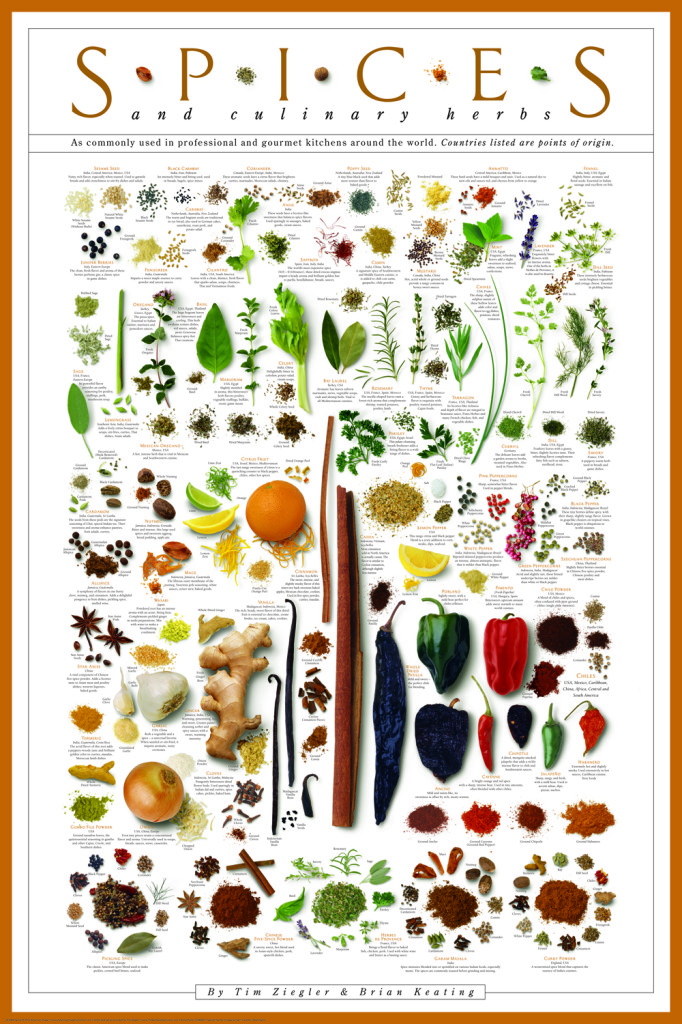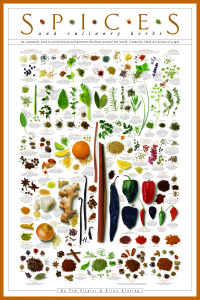
The Anatomy of The SPICES Poster

The SPICES Poster depicts seeds, herbs, spices, citrus, garlic and onion, peppercorns, capsicums, and foundation blends. The images are laid out to easily illustrate the fundamental culinary uses.
Seeds: Culinary spice seeds are literally and figuratively the fruit of culinary herbs. All culinary spice seeds create flavor bursts when used in soups, sauces, or grilling blends. Seeds, due to their yields, are usually affordable and are a great value. As chefs return to artisan recipes and use traditional recipes, seeds are again increasing in popularity.
Herbs: Bright in color, aromatic in fragrance, clean, twig free, and very high in essential oils, herbs are the backbone of the SPICES Poster. The herbs category gives you exceptional flavor, color, and leaf integrity.
Citrus: While not technically a spice, citrus fruit peels are essential flavoring ingredients. Look for fine cut peels from grapefruit, lemon, lime, orange, and tangerine and also for concentrated dry juice powders. These versatile powders as a rule elicit a “wow!” after tasting. Chefs frequently use these ingredients in their recipe blending to bring out the tart, tangy flavors of Mexican and Asian cuisine.
Capsicums: Capsicums are chili peppers, paprika, and the overwhelmingly hot capsicum chinense – habanero and scotch bonnet peppers. All chilies contain the active ingredient, capsacin. As the popularly of chipotle chilies has become increasingly more widespread, you can find some peppers for pretty cheap. But be wary. These low prices are achieved by burning pallets, tires, and trash to smoke their chilies instead of Mesquite wood. Do you really want the smell of burning rubber tires in your Mexican Cuisine?
Garlic & Onion: Because garlic and onion flavors are the absolute core of so many dishes and cuisines, it was a MUST for the SPICES poster. Nutty, intense, and delicious, garlic, onion, shallots, chives, leeks, toasted onion, and garlic are building blocks upon which every chef’s recipes can be developed.
Peppercorns: They come from Telicherry, Malabar, and Lampong – some of the finest pepper producing regions of the world. Black pepper is where the word “spicy” is derived. The berry is grown in a raceme similar to grapes. Flavor nuances are detectable in peppercorns just as they are in chardonnay or pinot noir.
Blends: At Gran Cucina (the spice division at Italco Foods where I oversee the program), we have more than 200 proprietary blends available. There are a lot of reasons to rely on blends—a topic for another blog post. But for now, take a look at some traditional blends like curry and Chinese five-spice to understand the power of a spice blend.
***
Stay tuned for more information on the SPICES Poster. We’ll dig into each of the eight categories in the coming months. Oh, and if you’d like to purchase your own copy, here’s the way!




